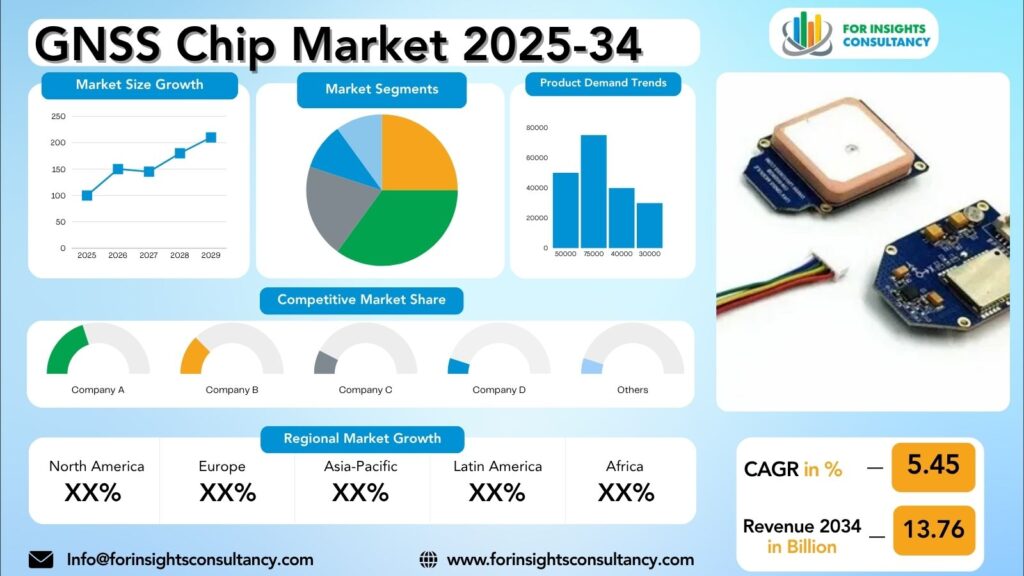
GNSS Chip Market Size, Trends Analysis Research Report by Device Type (Smartphones, Tablets Wearables, Personal Tracking Devices, Low-Power Asset Trackers), by Application (Navigation, Mapping, Location-Based Services, Surveying, Telematics, Timing and Synchronization, Others) and, by End-User (Automotive, Aerospace Defense, Maritime, Rail, Agriculture), and By Region Global Market Analysis And Forecast, 2025-2034
Oct-2025 Formats | PDF | Category: Electronis & Semiconductor | Delivery: 24 to 72 Hours
GNSS Chip Market Is Forecast to Increase from USD 8.34 Billion In 2025 To USD 13.76 Billion By 2034, At A CAGR Of 5.45%.
GNSS Chip Market: A Comprehensive Overview and Future Developments
The market for GNSS chips is expanding rapidly. The demand for location-based precision services, which include a 24-hour GPS, combined with the latest technology, have contributed to the strong demand scenario using various sectors, is the main driver of the market for this kind of chips resulting in a remarkable market expansion. This broad view comprises the major players, market dynamic, and technological advancements that are transforming the industry landscape. The adoption of technologies such as multi-constellation support and real-time kinematic positioning has made GNSS chips progressively more accurate and reliable.
Over the course of the coming years, the GNSS chip market will likely focus on the following aspects: improvement of position accuracy, lowering of power consumption, and increasing chip functionality to accommodate new applications like autonomous vehicles and IoT. The GNSS chip market, on the other hand, is still full of possibilities for the future, with plenty of innovations and developments over the next few years.
Market Insights
- In 2024, the GNSS Chip Market is expected to see substantial growth, with the largest revenue share projected to come from the Asia-Pacific region. The growth forecast for this region is expected to be driven by increased adoption of GNSS technology in various industries such as automotive, agriculture, and logistics.
- In the U.S., around 82% of the population is estimated to reside in urban areas, indicating a high potential for GNSS Chip market penetration in urban-centric applications like transportation and smart city initiatives.
- Across market segments, the largest revenue share is expected to come from the automotive sector, driven by the increasing demand for connected vehicles and advancements in autonomous driving technology. This trend is likely to further boost the overall growth of the GNSS Chip Market in 2024.
Market Dynamics
Trends
The GNSS chip market is being influenced by several trends, which include the need for location-based services that are accurate to a very high degree, the use of autonomous vehicles and drones that has been increasing rapidly, the employment of GNSS chips in smartphones and wearable devices for location tracking and navigation, the facilitation of accuracy and reliability in positioning technologies being a focus of the industry. Moreover, the market is growing due to the progress in chip manufacturing technologies that include the production of smaller and more power-efficient chips. There is also a move towards the combination of different GNSS systems such as GPS, Galileo, GLONASS and BeiDou in one single chip to get better positioning accuracy and reliability in different application areas and this trend is going further.
Growth Drivers
GNSS (Global Navigation Satellite System) chip market has been rising significantly due to various factors. One of the major factors leading to this growth is the rising demand for location-based services with high precision in different sectors like transportation, farming, communication, etc. Another factor is the use of GNSS technology in self-driving cars and drones, which leads to the market growth. Moreover, the increase in the usage of wearables and smartphones equipped with GNSS has also been supporting the growth of the market. Besides that, the developments in GNSS chip technology, e.g., higher accuracy, quicker time to first fix, and lower power consumption, are also attracting more users to this technology in various application areas, thus leading to the market growth. All these factors are together pushing the GNSS chip market to the next level of success.
Restraints
One of the limitations for the GNSS chip market is a development process that is very expensive and also the implementation of advanced GNSS technologies. Besides that, the problem of signal interference, precision, and availability in urban canyons, indoors, and under very thick foliage makes it difficult for the technology to be used everywhere. In addition to that, the regulations and the ownership of intellectual property also affect the growth of the market as well as the innovation. On the other hand, there are worries about privacy and security in GNSS, for example, in location tracking and hacking, which are some of the major obstacles to this market. These restraints overall function as main stakeholders in the GNSS chip market who are searching for solutions to these challenges and intend to propel the progress of the industry further.
Opportunities
New opportunities are favoring the GNSS chip market to grow double-digit in the next few years. Precise positioning and navigation services have become the need of the day for industries ranging from automotive to agriculture and logistics, resulting in demand that will likely elevate the GNSS chip market to new heights. Besides, the getting-much-popular trend of installing GNSS technology in smartphones/wearable devices for providing location-based services is also fueling the market expansion. On top of that, the technological breakthroughs in the field of GNSS chips such as completion of multi-constellation systems and achieving higher accuracy are presenting so many new ways for the market players to win the customer loyalty. To sum it up, the GNSS chip market is a great setting for the companies that are willing to come up with a new product to meet the rising demand of location-based services.
Challenges
Despite the technological progress made at a rapid pace, the GNSS chip market still has to tread several obstacles. One of the chief impediments to the GNSS chip market is that there is a growing necessity for pinpoint exactness in the inner city canyons and indoor situations, yet the satellite signals are very weak or completely blocked. Besides that, there is also a necessity for more efficient power usage so that the battery of the devices that utilize GNSS chips can last longer. In addition, compatibility with different satellite constellations and the advent of such technologies as 5G and IoT still pose a problem for the manufacturers of GNSS chips. Hence, the taking of these challenges on is going to be key for the GNSS chip market to be able to keep on with its expansion and be competitive in the future.
GNSS Chip Market Top Companies Covered In This Report:
Evaluate The Strategic Positioning And Innovation Pipelines Of Leading Market Companies-From Multinational Enterprises To Disruptive Regional Firms. Understand How Key Players Are Innovating, Expanding, And Capturing Value, And Use Competitive Benchmarks To Plan Your Next Move.
- Skyworks Solutions
- Quectel Wireless Solutions
- Navika Electronics
- STMicroelectronics NV
- Intel Corporation
- MediaTek Inc.
- Furuno Electric
- Broadcom Limited
- Qualcomm Incorporated
- U-Blox Holding AG
GNSS Chip Market Company News 2024 and 2025
Quectel Wireless Solutions
Quectel Wireless Solutions launched a new QLM29H dual-band GNSS smart-antenna receiver in 2024 supporting L1/L5 and multi-constellation tracking.
In March 2025, Quectel introduced LG580P, a multi-constellation, multi-band module supporting L1, L2, L5, L6 and interference mitigation.
STMicroelectronics NV
STMicroelectronics NV announced in February 2025 its new Teseo VI receivers, the first to integrate multi-constellation, quad-band GNSS and safety-level capabilities for automotive and industrial applications.
In mid-2025, ST agreed to acquire NXP’s MEMS sensors business, broadening its sensors portfolio (which may help in integrated GNSS + inertial sensor solutions).
U-Blox Holding AG
In early 2025, u-blox decided to phase out its loss-making cellular IoT business to focus more on its GNSS/positioning core.
Segmented View of The Industry:
The GNSS Chip Market Is Mapped Through A Multidimensional Lens-Tracking Shifts Across Product Type, Applications, And Geographic Regions. This Segmented Approach Enables Businesses to Localize Their Growth Plans And Align Offerings With The Most Profitable Demand Centres.
Segmentation By Device Type
- Smartphones
- Tablets & Wearables
- Personal Tracking Devices
- Low-Power Asset Trackers
Segmentation ByApplication
- Navigation
- Mapping
- Location-Based Services
- Surveying
- Telematics
- Timing and Synchronization
- Others
Segmentation By End-User
- Automotive
- Aerospace & Defense
- Maritime
- Rail
- Agriculture
Global Geographic Coverage:
The Report Provides In-Depth Qualitative And Quantitative Data On The GNSS Chip Market For All Of The Regions And Countries Listed Below:
North America
A major expansion of the GNSS chip market in the North American region is expected. The main factor behind this is a forecast of 6% GDP growth and an inflation rate of 2%. Government subsidies for GNSS technology in autonomous vehicles are set to become the leading factor in the United States, resulting in the sector’s rapid adoption and the development of new products. The major distribution channel for GNSS chips is through technology retailers that are specialized, whereas the online sales channel is considered the fastest-growing due to the convenience and accessibility of consumers.
In the North American region, sustainability and responsible sourcing have become a key purchasing factor for consumers, and more are choosing products that match their values. In developing markets, where price and status are still the main drivers, there is a trend of turning to sustainable and locally produced GNSS chips for the reason that this is a global trend of conscious consumption.
Europe
The GNSS chip market in Europe has been forecast to have its positive development consisting of the following how the region will keep its GDP growing at a moderate pace and have a very low CPI. One of the most important factors for the emergence of the French market for GNSS chips is the government aid for technology, which is going to be a key driver of the demand in different sectors for this kind of chip.
By far the most significant way for the distribution of GNSS chips in the region is through the online retail channels, while the newest and most rapidly developing way is by specialized technology stores.
Sustainability and the ethical sourcing of products have become very significant for European consumers when buying electronic devices, as a result, many sellers have to take these issues into their consideration.
The consumer market in Eastern Europe, considered an emerging market, illustrates that in that locale, price and prestige are still the main factors of consumer choice, showing that there are different consumer priorities between various sub-regions in Europe.
Asia Pacific
Asia Pacific GNSS chip market is positively moving ahead with the steady path of GDP growth of 5.5% and inflation rate of 2.8%. South Korea is typical example of local driver where the government grants subsidies to support the adoption of GNSS (Global Navigation Satellite System) technology in different fields. The main selling channel of GNSS chips is the online retail where the booming channel is the direct sales to businesses.
In Japan, consumers are placing more and more emphasis on sustainability and ethical sourcing, and the market is adapting to this trend by focusing on eco-friendly products. The consumers in India are passionate about localism, as the demand for products made in the country is very strong. Meanwhile, in the emerging markets of Vietnam and Indonesia, prices and the desire for status still rule the roost in consumer preference, consequently, affordable GNSS chip options are in high demand.
Middle East and Africa
The GNSS chip market in the Middle East and Africa is going through a substantial increase that is mainly driven by the region’s predicted GDP growth rate and inflation rate. In the Middle East, the UAE is at the forefront of this demand growth, mainly as a result of the government’s technology adoption-specific subsidy. This subsidy encourages businesses to invest in newer technologies such as GNSS chips.
In Africa, South Africa is distinguished by a one-of-a-kind cultural festival that is at the heart of innovation and, thus, the GNSS chips’ adoption. The leading channel for the distribution of GNSS chip is through partnerships with local telecom providers, whereas the online sales channel is the fastest-growing one by volume.
In the region, consumer concerns for sustainability and ethical sourcing are becoming major issues, particularly in emerging markets where price and status are the main factors considered.
Reasons To Buy:
- The Research Would Help Top Administration/Policymakers/Professionals/Product Advancements/Sales Managers And Stakeholders In This Market In The Following Ways.
- The Report Provides GNSS Chip Market Revenues At The Worldwide, Regional, And Country Levels With A Complete Analysis To 2034 Permitting Companies To Analyze Their Market Share And Analyze Projections, And Find New Markets To Aim For.
- To Understand The Most Affecting Driving And Restraining Forces In The Market And Their Impact On The Global Market.
- Major Changes And Assessment In Market Dynamics And Developments.
- The Objective Of The GNSS Chip Market Report Is To Identify New Business Opportunities Using Quantitative Market Forecasts.
- Formulate Sales And Marketing Strategies By Gaining An Understanding Of Competitors, Their Positioning, And Strengths & Weaknesses.
Faq – What Global Leaders Are Asking
What is the projected market value of the GNSS chip market?
GNSS Chip Market Is Expected To Achieve A Stable Growth Rate With A Compound Annual Growth Rate (CAGR) Of About 5.45% From 2025 Through 2034.
What are the main drivers of growth for the GNSS chip market?
The GNSS chip market is driven by rising demand for location-based services in smartphones, vehicles, and IoT devices. Additionally, advancements in multi-constellation and dual-frequency GNSS technologies are enhancing accuracy and expanding industrial and automotive applications.
Who are the major players in the GNSS chip market?
The GNSS Chip Market Includes Major Companies Skyworks Solutions, Inc. (US), Quectel Wireless Solutions Co., Ltd. (China), Navika Electronics (India)., STMicroelectronics NV (Switzerland), Intel Corporation (US), MediaTek Inc. (Taiwan), Furuno Electric Co., Ltd. (Japan), Broadcom Limited (US), Qualcomm Incorporated (US), U-Blox Holding AG (Switzerland), Others.
Which region holds the largest GNSS Chip market share or is growing the fastest?
Asia-Pacific holds the largest GNSS chip market share, driven by high smartphone adoption, expanding automotive production, and smart city initiatives. North America is growing rapidly due to increasing demand for autonomous vehicles and precision agriculture technologies.
What challenges face the GNSS Chip market?
The GNSS chip market faces challenges such as signal interference, multipath errors, and vulnerability to spoofing or jamming. Additionally, high power consumption and integration complexity in compact IoT devices hinder widespread adoption.
Customized Report as per your Business Needs
- Our analysts will work directly with you and understand your needs
- Get data on specified regions or segments, competitor and Vendors
- Data will be formatted and presented as per your requirements
Any Requirement Contact Us: Https://Www.Forinsightsconsultancy.Com/Contact-Us/
Table of Contents
For TOC Contact us: https://forinsightsconsultancy.com/contact-us/






